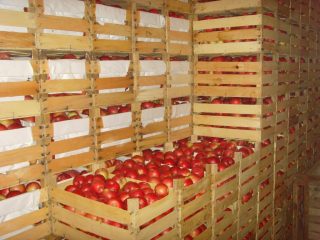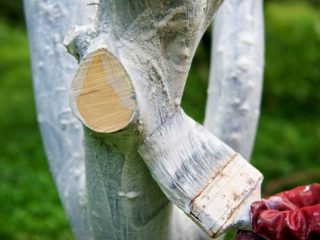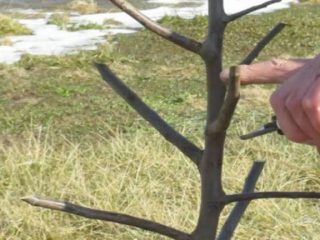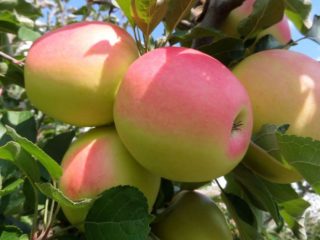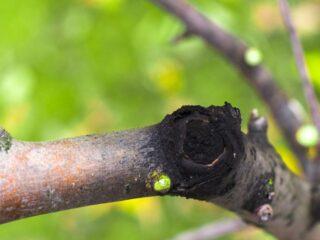Content
Planting of columnar apple trees in the spring should be carried out in the second half of April, and in some regions - in early May. Seedlings are purchased in advance in the fall and stored in a cool room at zero temperature. Planting holes are prepared about a month in advance, after which the seedlings are placed in rows with an interval of 1-2 m.
Rules for planting columnar apple trees in spring
Planting of apple trees of various types, including columnar ones, is planned for the fall. But spring planting is also allowed. This period is especially suitable for regions with extreme frosts, for example, Siberia.
When planting in spring, there are several things to consider:
- It is very important to plan a deadline - there is no need to rush. It is better to plant seedlings in the second half of April or even in May, when the soil warms up well enough.
- Typically, specimens of columnar apple trees are purchased in the fall.Therefore, seedlings need to be provided with normal storage conditions. This could be a basement or cellar with a constant temperature of about 0-2 degrees Celsius.
- The site should be prepared in advance. To plant a columnar apple tree in the spring, the soil is dug up in the fall. Add compost or humus and add sand if necessary.
- Plan a planting plan in advance. Trees with a columnar shape are very compact, so they can be placed even with a minimum interval of 1-2 m. If there are a lot of seedlings, they are arranged in rows in a checkerboard pattern.
Preparing for planting columnar apple tree seedlings in spring
When preparing for planting, you need to choose a place and buy a seedling, as well as plan the timing. If you plant plants in the spring (approximately the second half of April), the soil should be prepared in the fall.
The soil is dug up using a shovel and a bucket of compost or humus is added to each square meter. If the soil is heavy and contains a lot of clay, it is necessary to add sawdust or sand up to 2-3 kg to the same area. If necessary, measure the pH. If it turns out to be less than 5.5, add dolomite flour or wood ash - 200-300 g per 1 m2.
Planting dates for columnar apple trees in spring
When planning to plant columnar apple trees in the spring, special attention should be paid to choosing the right time. Usually the work is scheduled for the middle or second half of April. At this time, the soil is already warming up sufficiently, the snow cover is melting in all regions, and the temperature day and night is consistently above zero.

Columnar apple trees are planted in the second half of April
Specific dates depend on the climate of the region:
- In the middle zone, planting is planned for the 2-3rd decade of April.
- In the south, you can plant columnar apple trees in the spring and at the end of March.
- In the Urals - in the third ten days of April. In Siberia, the dates are approximately the same, but they may shift until the first half of May.
Selecting a location
Since the apple tree grows in the same place without replanting for 10-20 years or more, it is necessary to select a site in advance. The territory must meet several criteria at once:
- Good lighting. There should be no shadow. Therefore, for spring planting of a columnar apple tree, choose an area remote from buildings, large trees and shrubs.
- Without accumulation of water after rains - the place should be located on a hill. It is not worth choosing a lowland.
- Close approach of groundwater is not allowed. Their maximum height should not exceed 1.5 m from the ground surface.
- Spacious area with good air access. If possible, it should be protected from north winds, for example by a fence or house.
- It is advisable to plant a columnar apple tree seedling in the spring next to pears, plums or rowan trees.
Seedling storage
Seedlings are usually purchased in the fall, since at this time the assortment is noticeably richer. They can be kept in their normal form until planting in the spring. In regions with relatively mild winters, for example, in the south, you can simply dig it into the ground and carefully cover it with mulch. The branches themselves and the main shoot are wrapped with dense agrofibre.
In the middle zone, the Urals, Siberia, and northern regions, it is better to store directly in a container in a cool room.This could be a basement, cellar, barn or balcony. It is necessary that the temperature does not fall below -5 degrees, but does not rise above +5. Once a month it is recommended to water with a small amount of settled water.
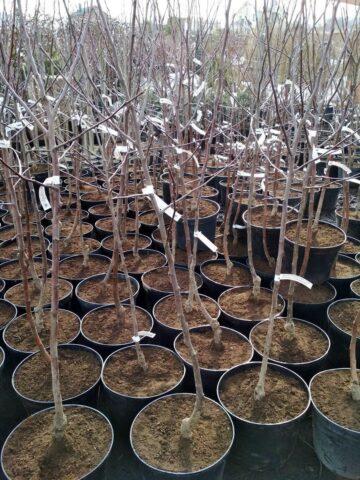
Seedlings are purchased in the fall and stored in cool rooms until spring.
If there is no storage space or it is not possible to create suitable conditions, you can purchase planting material after winter. If it has an open root system, it should be planted immediately. If the roots are closed (in a container), you can keep them at home for up to 1-2 months.
Pit preparation
Before planting a columnar apple tree in the spring, you need to prepare a hole, following these recommendations:
- If the soil is fertile and loose (loam), the depth should exactly match the roots. They are placed freely in the hole.
- In other cases, a depth of 60-90 cm is sufficient.
- The width of the holes should be slightly larger - 80-100 cm.
Holes for planting columnar apple trees in the spring should not be prepared in the fall. They can be dug in April, two weeks before the start of work. The hole is dug to the required depth and width. A layer of pebbles and small stones for drainage is placed on the bottom - a height of 25 cm.
Then you need to lay fertile soil. To do this, humus is mixed with turf soil in a ratio of 1:2. You can also add 1 part each of black peat and sand. 1 kg of superphosphate and wood ash are poured into each hole. Next, it is dropped in drops and allowed to stand for 2-3 weeks before planting the seedlings.
Instead of a hole, you can also prepare landing trenches. Their depth and width are approximately the same - 60-80 cm each. The preparation rules are exactly the same - a layer of stones is placed on the bottom, and then fertile soil. They are allowed to stand for two to four weeks, then they begin to place the seedling on the site.
Root treatment
Proper planting of a columnar apple tree in the spring involves treating the roots. If the seedling is sold in a pot, it must be thoroughly watered the day before planting. If the root system is open, it is placed in a “chatterbox” of water and clay for a day. A few drops of a growth stimulator solution, for example, Epin, Zircon, Energen, are added to the mixture.
It is also recommended to first inspect the roots and remove dried parts. Weakened ends are trimmed as they will die anyway. Only healthy shoots should be left.
At what distance to plant columnar apple trees in spring?
There is a general rule that when planting apple trees, you must leave a 7 m interval between tree trunks. At the same time, their closest branches to each other should not be closer than 2 m.
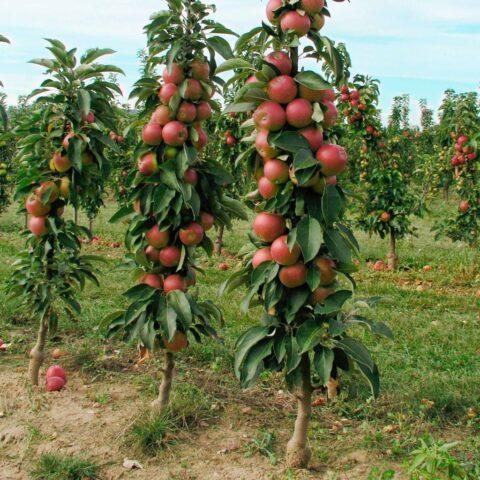
Compact seedlings can be planted at a minimum distance of 60-70 cm
The columnar apple tree has a small crown, so the planting pattern in the spring can be changed. As a rule, trees are planted in one row at a minimum distance of 1 m (between planting holes). If possible, it is better to increase the interval to 2 m. The second row is laid according to the same pattern, moving in a checkerboard pattern. The distance between rows is at least 1 m.
How to plant a columnar apple tree in spring
You can plant a columnar apple tree in the spring based on the following step-by-step instructions:
- Dig holes, remove soil down to the layer of stones.
- Place a wooden stake in the center.
- Place the seedling and carefully straighten the roots.
- Sprinkle with soil, lay it so that the grafted area is 5 cm above the surface.
- Tie the tree to a stake.
- Give two buckets of settled water.
- Trim side shoots by a third.
- Lay down a layer of straw, sawdust or other mulch.
Aftercare
When planting columnar apple trees in the spring, it is necessary to take into account the peculiarities of care. In order for a seedling to take root, it needs to be watered regularly, pruned, and treated against diseases and pests. The basic rules and recommendations of experienced gardeners are described below.
Watering
Young seedlings need to be watered regularly. After spring, the soil remains moist for a long time. As soon as the soil dries, the seedlings are watered every week, giving one bucket of water.
Adult columnar apple trees in the second year after planting in the spring should be watered 2-3 times per season. They are given from 5 to 8 buckets of water at a time - the total volume depends on age.
During drought, watering should be done 2-3 times a month. In the evening, the crown is sprinkled. This should be done during sunset or after it, so that the leaves do not suffer from sunburn.
After watering or heavy rains, the soil must be loosened. At the same time, weeding is done. To keep pests as low as possible, it is recommended to lay a layer of straw, hay or other mulch. It will also protect the roots from return frosts in the spring.
Fertilizer
In the first season after planting a columnar apple tree in the spring, there is no need to replant. The soil is quite fertile, and fertilizers are added when forming the pit. Overfeeding is worse than underfeeding, so feeding in excess amounts is definitely not worth it.
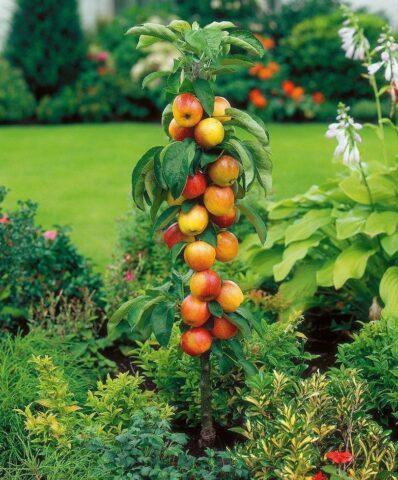
To obtain a good harvest, columnar apple trees are fed 2-3 times per season.
Starting from the second year, fertilizers are given regularly:
- When the leaves bloom in the spring, urea or ammonium nitrate is applied. Granules are spread on the soil in an amount of 50 g per 1 m2and then watered with water at room temperature.
- During the formation of buds, superphosphate is given (80 g per 1 m2) and potassium sulfate (50 g per 1 m2).
- After harvesting, you can water it with an infusion of wood ash (200 g per 10 l).
Trimming
Immediately after planting a columnar apple tree in the spring, the side shoots are shortened by a third of their length to stimulate new growth points. At the same time, it is necessary to shorten the main trunk.
In the future, pruning is carried out regularly. Every spring, weak, damaged, old and broken branches are removed. In the fall, a shaping haircut is done. The cutting diagram is as follows:
- In the second year, young shoots over 30 cm long are pinched, leaving the top one.
- In the third season, the crown is pinched at a distance of 25 cm from the trunk. Side shoots are shortened to 40 cm.
- In the fourth year, last year's branches are thinned out.
- On the fifth day, the height of the columnar apple tree is limited to 3 m.
Treatments for pests and diseases
Preventative treatments should be carried out every spring. Even before the buds swell, the seedlings are treated with fungicides:
- "Bordeaux mixture";
- "HOM";
- "Abiga Peak".
At the beginning of summer it is recommended to treat with insecticides:
- "Decis";
- "Fitoverm";
- "Agravertine";
- "Match".
Shelter for the winter
Young seedlings must be covered for the winter. With the onset of frost, the soil is mulched, and the trunk itself is wrapped in dense agrofibre. The material must be well breathable so that the columnar apple tree seedling does not rot. In mid-spring, the shelter is removed.
Conclusion
Planting columnar apple trees in the spring should be carried out according to general rules. It is better to prepare the site in the fall. Caring for seedlings does not require much effort. In the first year they are watered abundantly, and starting from the second season, fertilizing is regularly applied. It is also necessary to carry out pruning and preventative treatments against pests.
